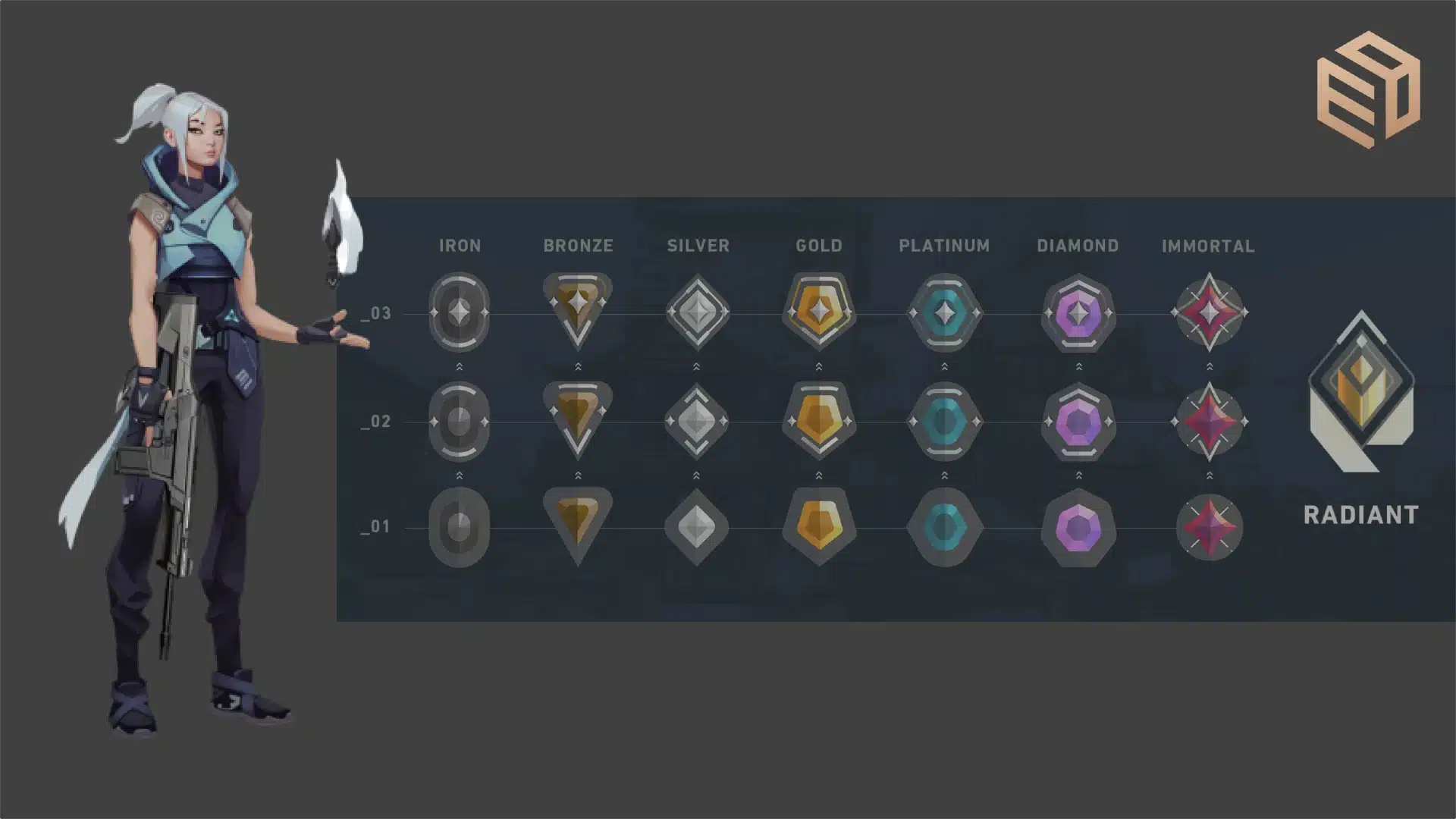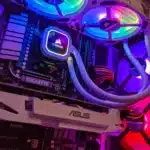The world of Riot Games’ enthralling FPS, Valorant, beckons to both the casual gamer and the hardened veteran… In this comprehensive guide to Valorant ranks, we’ll explore the ranking system, discuss the significance of various ranks, provide useful tips to climb the rank ladder, and even address common questions and misconceptions.
Decoding Ranks in Valorant

Welcome to the dynamic world of Valorant’s ranking system. The ranks within Valorant are an accurate representation of your skill level, performance, and status among the game’s community. Navigating through these ranks might seem like a challenge, but we’re here to help. This guide will take you through the nitty-gritty of the Valorant ranking system, its various components, and how each component contributes to your overall gaming journey. In addition, we’ll discuss the progression process, detailing how players can move up in ranks and the effort required to maintain them.
An Overview of all valorant ranks
The ranking system in Valorant is comprehensive and detailed. It’s divided into several tiers, with each tier further broken down into three divisions. The tiers, in ascending order, are Iron, Bronze, Silver, Gold, Platinum, Diamond, Ascendant, Immortal, and Radiant. Each rank signifies a leap in skill level, with Iron representing beginners and Radiant standing for the crème de la crème of Valorant players.
VALORANT RANKS IN ORDER
- Iron 1
- Iron 2
- Iron 3
- Bronze 1
- Bronze 2
- Bronze 3
- Silver 1
- Silver 2
- Silver 3
- Gold 1
- Gold 2
- Gold 3
- Platinum 1
- Platinum 2
- Platinum 3
- Diamond 1
- Diamond 2
- Diamond 3
- Ascendant 1
- Ascendant 2
- Ascendant 3
- Immortal 1
- Immortal 2
- Immortal 3
- Radiant
Significance of Valorant Ranks
Valorant ranks are more than just symbolic representations of a player’s skill level. They also serve as motivation, as seeing your rank progress can inspire you to invest more time in improving your gameplay and achieving higher ranks. They serve as badges of honor, demonstrating your dedication, hard work, and mastery over the game. As you climb the ranking ladder, your progress gives you insights into your gaming evolution and your standing within the Valorant community. Moreover, the ranks help benchmark your performance, enabling you to identify areas of improvement and fueling your journey toward becoming a better player.
Act Rank and its Connection to Proven Skill
Another intriguing facet of Valorant’s ranking system is the ‘Act Rank.’ Your Act rank is an emblem of your performance during a specific Act, with each Act spanning over a couple of months. The Act rank is determined based on your best nine ranked match wins of the Act and the number of wins you have in the Act. Higher Act ranks often come with unique rewards such as badges and gun skins. It symbolizes your highest achieved rank, or your “proven skill,” during the Act. Your performance in each Act has a bearing on your overall journey in Valorant, influencing the rewards you receive at the end of each Act and shaping your gaming narrative.
In-Depth Look at Valorant’s Ranking Tiers
To get the most out of your Valorant experience, it’s important to understand the game’s ranking tiers in detail. For instance, an Iron player might be focused on understanding agent abilities, while a Radiant player would be expected to have a deep understanding of map strategies, agent synergy, and advanced shooting mechanics. Each tier within Valorant represents a distinct level of skill and gameplay understanding. This section aims to demystify these tiers and help you recognize what each one represents in your journey toward mastery.
From Iron to Radiant: Exploring the Different Tiers
The ranking system in Valorant begins at Iron and concludes at Radiant. Each tier signifies a unique set of skills and gameplay understanding. For example, Bronze players might struggle with team coordination and effective use of agent abilities, while Diamond players may be refining advanced tactics such as site retakes and economy management. Iron-level players are usually the ones taking their first steps in Valorant, getting a grip on the game’s mechanics and strategies. On the opposite end, the Radiant players are the elite, those who have successfully mastered every aspect of Valorant. They are considered the best in terms of skill, strategic execution, and gameplay proficiency.
Characteristics and Skill Levels of Each Rank
Each rank in Valorant is associated with a unique set of skills and gameplay understanding. For instance, Iron players may be in the early stages of learning the game, grappling with basics like agent abilities, map layouts, and shooting mechanics. Meanwhile, Radiant players are expected to have achieved mastery in these aspects, demonstrating exceptional strategic depth, teamwork, and an effective execution of agent abilities. By understanding the skill level associated with each rank, players can better identify their own strengths and areas for improvement.
Climbing Valorant Rank Ladder: Strategies and Tips
Making your way up the Valorant ranking ladder involves more than just understanding the game’s ranking system. We’ll delve into strategies such as communication and teamwork, understanding your agent’s abilities, refining your shooting mechanics, and learning from past games to help you ascend the ranks quicker. It requires consistent strategy application, skill refinement, and a profound grasp of the game’s mechanics. The following strategies and tips can guide you in your journey toward the top ranks.
Embrace Teamwork
Valorant is a team-based game, and as such, individual prowess alone won’t propel you to the higher ranks. Effective teamwork plays a crucial role in both strategic planning and the execution of maneuvers during a match. Open lines of communication with your teammates, share your strategies, and be receptive to their ideas. A well-coordinated team often has an advantage over a collection of individually talented players.
Understand Your Agents
Each Valorant agent possesses unique abilities that, when utilized correctly, can offer a significant edge during a match. Make it a point to thoroughly understand these abilities and how they can be effectively deployed in various situations. By mastering your agent’s abilities, you not only enhance your own gameplay but also contribute more effectively to your team’s overall strategy.
Improve Your Shooting Mechanics
While strategy and teamwork are integral components of Valorant, your shooting skills hold equal importance. Practice in aim training mode, familiarize yourself with the recoil control, and study the bullet spread patterns of different weapons. Remember, a well-placed shot can drastically alter the outcome of a match.
Learn From Your Games
Don’t let a loss dishearten you. Every game, whether a victory or defeat, presents an opportunity for learning and improvement. Analyze your past matches, identify mistakes, and concentrate on enhancing those areas. Observing gameplay of players at higher ranks can also offer valuable insights and tips for your own improvement.
Updates and Changes in Valorant Ranking System Over Time
Riot Games, the developer of Valorant, consistently adapts and refines the ranking system in response to player feedback and in-game statistics. For instance, in one of the early updates, Riot Games adjusted the amount of ranked rating points players gain or lose based on their performance to provide a smoother progression experience. This iterative process ensures a balanced and competitive environment for all players. Here are some notable updates and changes that have been introduced to the Valorant ranking system:
Introduction of Act Rank Badges
In Act II, Riot Games introduced the Act Rank Badges. These badges reflect your “proven skill”, representing the highest rank achieved during a specific Act, and display the number of wins attained at that rank. This development added a new layer of accomplishment for players to strive towards and changed the Valorant ranking system’s landscape.
Adjustment of Rank Progression
Responding to community feedback, Riot Games adjusted rank progression by modifying the number of ranked rating points players gain or lose. This alteration aimed to balance the ranking system better, smoothing rank progression and aligning more closely with player performance.
Improved Matchmaking System
Riot Games also worked on refining the matchmaking system with an objective to pair players with comparable skill levels. This improvement has significantly enhanced the competitive integrity of ranked games, ensuring a fairer and more balanced matchmaking for all players.
Valorant Ranks: Common Questions and Misconceptions
When it comes to understanding Valorant ranks and the ranking system, several questions frequently come up. Here, we tackle some of the most common inquiries and misconceptions. In addition, we’ll also tackle misconceptions such as ‘Higher ranks are only for professional players’ or ‘I can’t rank up as a solo player’ to ensure you have a clear and accurate understanding of the ranking system.
Yes, your Valorant rank significantly influences who you get matched with during competitive play. The game strives to pair players of similar skill levels, largely determined by their rank rating.
Valorant ranks reset with each new Act, typically occurring every two months. However, your MMR (Matchmaking Rating) remains somewhat preserved, influencing your placement in the subsequent Act.
While playing with a coordinated team can be beneficial, it’s entirely possible to progress through the ranks as a solo player. It might present a unique set of challenges, but with determination and continual skill improvement, you can climb the ladder on your own.
While it’s true that many professional players reside in the higher ranks (Ascendant, Immortal, and Radiant), these ranks also include non-professional players who have honed their skills. Achieving a high rank is more about dedication, strategy, and skill than professional status.
Conclusion
Valorant’s ranking system provides a roadmap for your progression in the game. We hope you found this guide useful. If you did, feel free to share it with your fellow Valorant players. And if you have any tips or experiences you’d like to share, please leave a comment below. Let’s all strive to improve and enjoy this fantastic game together! From Iron to Radiant, each rank represents a new level of skill and a new set of challenges. But remember, the journey through these ranks is not just about winning—it’s also about improving your skills, learning the game’s mechanics, and, most importantly, enjoying it. So whether you’re a seasoned player or just starting, Valorant’s ranking system offers an exciting journey of growth and mastery Stay resilient, learn from your mistakes, and never stop striving for that next rank. Happy gaming


